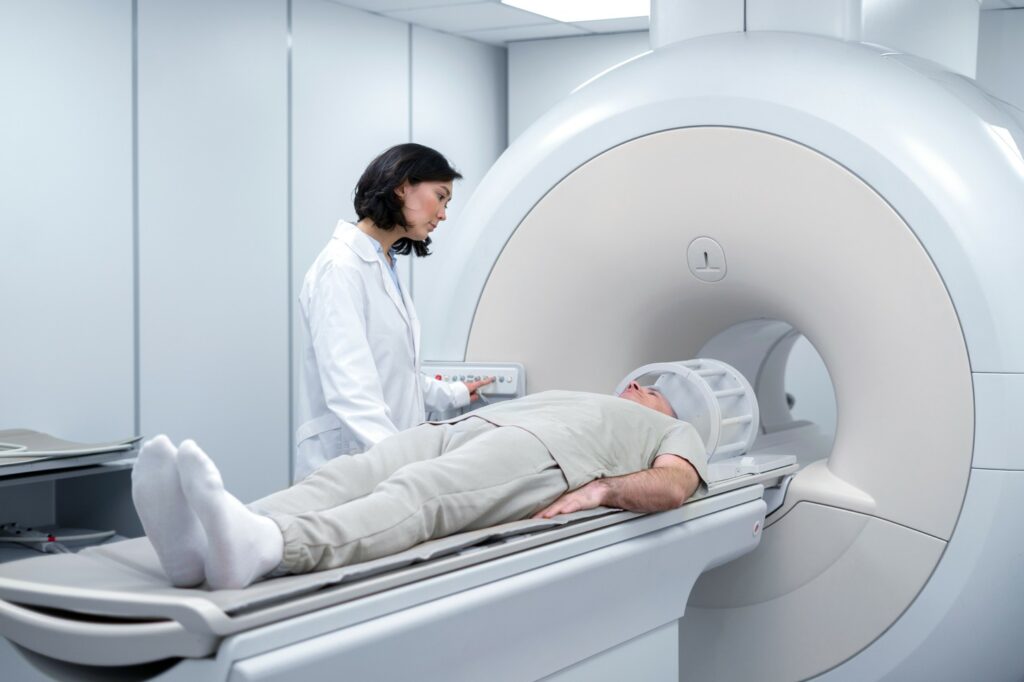Last Updated on November 4, 2025 by mcelik

At Liv Hospital, we use the latest tools to check your heart health. A CT coronary angiogram (CCTA) is a non-invasive test. It uses coronary computed tomography angiography to show detailed images of your heart and blood vessels.
This test is great for spotting coronary artery disease. It works by using a special dye and x-ray tech. This way, we can see the coronary arteries and find any blockages or issues.

CCTA, or Coronary Computed Tomography Angiography, is a non-invasive test that has changed cardiology. It gives detailed images of the coronary arteries. This lets us check their structure and function.
Coronary Computed Tomography Angiography (CCTA) is a test that uses X-rays to show the heart and blood vessels. It’s also known as a coronary CT angiogram. In medical terms, it’s a cardiac CT scan that looks at the coronary arteries.
The term CCTA means to see the coronary arteries and find any blockages or issues. Knowing what CCTA is helps patients understand its importance in checking their heart health.
The main goal of CCTA is to check the coronary arteries. It helps find blockages, narrowings, or other problems. These can show if someone has coronary artery disease.
CCTA is needed for some heart conditions, like congenital heart disease and heart failure. It gives cardiologists detailed images of the arteries. This helps them diagnose and manage heart conditions better.
CCTA is great because it’s non-invasive, very accurate, and gives a full cardiac check. It’s a key tool in cardiology. It helps us improve patient care and outcomes.

Advances in CCTA cardiology have changed how we spot coronary artery disease. The journey of coronary computed tomography angiogram technology has seen big steps. These steps have made it better at finding problems.
The start of CCTA technology was a few decades back. Early versions gave basic images but set the stage for better things to come. Over time, technological improvements have given us clearer images and more precise diagnoses.
The big jump in CCTA tech was the multi-slice CT scanners. For example, 64-slice computerized tomography (CT) scans have been key in advanced heart checks, as HCA Healthcare Trident Hospital points out. This step up meant quicker scans and clearer views of the heart’s arteries.
Recently, remarkable advancements have happened in heart imaging, thanks to AI and better detector tech. These changes have made images better and cut down on radiation, making CCTA safer and more useful.
The table below shows key CCTA tech developments:
| Year | Technological Advancement | Impact on CCTA |
|---|---|---|
| Early 2000s | Introduction of 4-slice CT scanners | Initial capability for coronary imaging |
| Mid-2000s | Development of 64-slice CT scanners | Improved resolution and faster scanning |
| Present day | Integration of AI and dual-source CT | Enhanced image quality and reduced radiation |
As we keep moving forward in coronary computed tomography, it’s clear CCTA cardiology will keep being key in diagnosing and treating heart disease. The future of CCTA looks bright, with ongoing research aiming to make it even better at finding problems and safer for patients.
A CCTA heart scan is a non-invasive test that uses top-notch imaging to see the coronary arteries. It’s key for spotting coronary artery disease and checking heart health.
The CCTA uses advanced CT scanning. Multi-detector CT technology quickly gets high-quality images of the heart. It shows the coronary arteries clearly, helping doctors find blockages or issues.
The CT machine moves around the patient, taking pictures from different sides. These images are put together to show the coronary arteries fully. State-of-the-art CT scanners make sure the images are sharp, helping doctors make accurate diagnoses.
The CCTA scan matches up with the patient’s heartbeats. This is done through electrocardiogram (ECG) gating. It makes sure images are taken at the same heart phase, reducing blurry spots.
ECG gating can work in two ways. It can take pictures at a set heart phase or capture images all the time and pick the best one. This makes the CCTA images even clearer.
Contrast dye is key for seeing the coronary arteries in a CCTA scan. It’s injected into a vein and shows up in the arteries. This makes it easier to spot any problems.
The dye used is usually iodine-based. Iodine-based contrast agents make the arteries stand out, helping doctors diagnose better. But, patients should tell their doctors about any dye allergies.
The CCTA scan combines advanced tech, heartbeat matching, and dye to check coronary artery health. It’s a non-invasive way to diagnose and manage coronary artery disease.
CCTA has changed cardiology by giving a non-invasive way to find coronary artery disease. We use this tech to see the coronary arteries clearly. This helps us find and manage heart problems early.
CCTA is great for spotting blockages and narrow spots in the coronary arteries. It helps us see how bad the disease is and what treatment is best. The clear images from CCTA let us catch even small blockages, helping patients get help fast.
Key benefits of CCTA in detecting blockages include:
CCTA also lets us see coronary plaque, which is key in understanding heart risk. By looking at the plaque’s makeup, we can guess if it might block the artery. This info helps us decide on treatments and how to prevent problems.
Knowing how bad stenosis is is key to treating coronary artery disease. CCTA gives us clear images to measure stenosis well. This helps us decide if a patient needs things like angioplasty or stenting.
| Stenosis Severity | Description | Typical Treatment |
|---|---|---|
| Mild | Less than 50% narrowing | Conservative management, lifestyle modifications |
| Moderate | 50-70% narrowing | Medical therapy, possible invasive testing |
| Severe | Greater than 70% narrowing | Invasive procedures (angioplasty, stenting) |
With CCTA, we can give patients the right diagnosis and treatment. This improves how we manage coronary artery disease.
The CCTA heart test is key for checking heart symptoms and finding coronary artery disease. It helps us see if patients have heart disease.
Chest pain is a big reason for getting a CCTA test. We suggest it for patients with angina or other chest pain signs. The test shows us the heart’s arteries and spots blockages or narrowings.
Shortness of breath, fatigue, and palpitations also need a CCTA test. It helps us understand the heart’s health and plan treatment.
Some risk factors increase heart disease chances. A CCTA test is suggested for those with high blood pressure, high cholesterol, diabetes, smoking, or heart disease in family.
| Risk Factor | Description | CCTA Recommendation |
|---|---|---|
| High Blood Pressure | Consistently elevated blood pressure above 130/80 mmHg | Recommended for individuals with uncontrolled hypertension |
| High Cholesterol | Elevated levels of LDL cholesterol | Suggested for individuals with high LDL levels and other risk factors |
| Diabetes | Presence of diabetes mellitus | Recommended for diabetic patients with other cardiac risk factors |
| Smoking | Current or former smoker | Suggested for smokers with other risk factors |
| Family History | First-degree relative with early coronary artery disease | Recommended for individuals with a strong family history |
In some cases, a CCTA test is the first choice for coronary artery disease. This is for patients at intermediate risk or with symptoms hard to diagnose.
Recent guidelines say CCTA is a good first test for chest pain and low to intermediate risk of heart disease. It’s non-invasive and accurate, helping us manage heart disease well.
Knowing when to use a CCTA heart test helps us diagnose and treat coronary artery disease better. This improves patient outcomes.
We’ll help you get ready for your CCTA procedure. It’s important to prepare well to get the best results. This means high-quality images and accurate test results.
You’ll get specific instructions before your CCTA heart scan. These might include:
It’s very important to follow these instructions carefully to make sure your CCTA test goes well.
Tell your healthcare provider about all the medications you’re taking. Some medications might need to be adjusted or stopped before the test. For example:
Always talk to your doctor before changing your medication.
You might need to follow certain dietary restrictions before your CCTA heart test. Common instructions include:
By following these guidelines carefully, you can help make your CCTA procedure a success. This way, you’ll get accurate diagnostic results.
Learning about the CCTA procedure can make patients feel more at ease. We’ll guide you through the steps of the CCTA heart scan. This includes preparation and what to do after the test.
Before the CCTA test, you’ll get specific instructions. These may include avoiding certain medications, fasting, and wearing comfy clothes. It’s also important to tell us about any allergies, like to contrast dye. And let us know about any health conditions, like kidney disease or diabetes.
During the test, you’ll lie on a table that moves into a CT scanner. The whole process is quick, taking just a few minutes. A contrast dye is injected into your arm to make your coronary arteries show up better. The CT scanner then takes detailed images of your heart.
After the test, you can usually go back to your normal activities right away. But, drinking lots of water is a good idea to get rid of the contrast dye. You might feel a warm sensation or taste something metallic, but these side effects are usually short-lived. We’ll give you all the details on what to do next and be here to answer any questions.
CCTA imaging has changed cardiology by giving clear images of the coronary arteries. It’s a non-invasive tool that helps find coronary artery disease and plan treatments.
Cardiologists look for signs of coronary artery disease in CCTA images. They check for blockages, narrowing, and plaque buildup. This helps them decide the best treatment.
They look at:
A CCTA report gives detailed info about your coronary arteries. It talks about any abnormalities and gives a calcium score.
It might be hard to understand your CCTA report at first. But, your healthcare provider will explain it to you. They’ll talk about what it means and what to do next.
Calcium scoring is a key part of the CCTA exam. It measures calcium in the coronary arteries, showing if there’s disease.
| Calcium Score | Risk Category | Interpretation |
|---|---|---|
| 0 | Very Low | No identifiable coronary artery disease |
| 1-100 | Mild | Low to moderate risk of coronary events |
| 101-400 | Moderate | Moderate to high risk of coronary events |
| >400 | High | High risk of coronary events |
Calcium scoring gives important info about coronary artery disease. It helps in planning prevention and treatment.
CCTA is a top-notch tool in cardiology, giving deep insights into coronary artery disease. We’ll look at how accurate CCTA is, its sensitivity and specificity, and how it compares to other methods. We’ll also see the research backing its effectiveness.
CCTA is very good at spotting coronary artery disease. It can find blockages and narrow spots in the arteries early. This lets doctors start treatment quickly.
Its accuracy comes from clear images of the arteries. This lets doctors see plaque and how severe the narrowing is.
A study in a top medical journal showed CCTA’s accuracy. It found a 95% sensitivity and 90% specificity in detecting coronary artery disease https://link.springer.com/article/10.1007/s00330-025-12048-4. This makes CCTA a trusted tool in cardiology.
CCTA is often compared to other tests like stress tests and invasive coronary angiography. While these tests are useful, CCTA is non-invasive and very accurate. Here’s a comparison:
| Diagnostic Method | Sensitivity | Specificity | Invasiveness |
|---|---|---|---|
| CCTA | 95% | 90% | Non-invasive |
| Invasive Coronary Angiography | 90% | 95% | Invasive |
| Stress Test | 70% | 80% | Non-invasive |
Many studies have shown CCTA’s value in cardiology. A leading researcher’s quote highlights its importance:
“CCTA has revolutionized the diagnosis of coronary artery disease, providing a non-invasive and highly accurate alternative to traditional methods.”
As cardiology advances, CCTA remains key in diagnosing and treating coronary artery disease. Its accuracy, non-invasive nature, and detailed images make it essential for cardiac patient care.
Coronary computed tomography angiography (CCTA) is a top choice for doctors. It’s non-invasive and checks the heart fully. This method has changed cardiology by giving a safe way to see heart disease.
CCTA heart scans are a big plus because they don’t hurt. Unlike old methods, they use a CT scanner, not catheters. This makes them safer and more comfortable for patients.
CCTA is so good, it means fewer people need invasive tests. It shows the heart’s arteries clearly. This helps doctors without the need for risky procedures.
CCTA heart scans give a full view of the heart. They spot problems like blockages. This helps doctors plan better care for their patients.
In short, CCTA is a key tool for heart disease. It’s safe, cuts down on risky tests, and checks the heart well. It’s a big win for cardiology today.
CCTA is a powerful tool for diagnosing heart issues. It provides detailed images of the coronary arteries. Yet, it has its own set of risks and limitations that need to be considered.
CCTA involves X-rays to see the heart and blood vessels. This raises concerns about radiation exposure. While the benefits are great, there’s a small risk of cancer from radiation.
To lower this risk, we use advanced tech. This tech helps reduce radiation doses without losing image quality.
Some ways to cut down radiation include:
The contrast dye in CCTA can cause allergic reactions. While rare, it’s important to know about any allergies or past reactions. This helps us prepare for the procedure.
People with kidney disease face higher risks from the dye. We check each patient’s history to decide if dye is safe. If not, we look for other options.
CCTA isn’t right for everyone. High heart rates or trouble holding breath can make it hard. Also, some stents or heavy calcification might need more tests.
Some limitations include:
In summary, CCTA is a valuable tool but comes with risks and limitations. We carefully consider these to ensure its benefits outweigh the risks. This way, we can use CCTA effectively in heart diagnostics.
A CT Coronary Angiogram (CCTA) is a key tool in cardiology. It lets doctors see the coronary arteries without surgery. This scan has changed how we check the heart, giving clear pictures of its structure and how it works.
Doctors use CCTA to find blockages and see plaque in the arteries. They can also check how severe the blockage is. This helps them plan better treatments and improve patient care.
The CCTA has grown better over time, thanks to new imaging tech and heart sync. Even though there are risks, its benefits make it very useful. It helps a lot in treating heart disease.
For people from other countries looking for top-notch medical care, CCTA is a great choice. As cardiology keeps getting better, CCTA will keep playing a big role in heart health.
A CCTA (Coronary Computed Tomography Angiography) test is a non-invasive imaging test. It uses X-rays to create detailed images of the heart and its blood vessels. This helps diagnose coronary artery disease.
A CCTA heart scan uses a CT scanner to take images of the heart and its blood vessels. The scan is timed with the heartbeat. A contrast dye is used to see the coronary arteries clearly.
A CCTA helps detect coronary artery disease and identify blockages. It also assesses how severe stenosis is. This information helps cardiologists diagnose and manage cardiac conditions.
To prepare for a CCTA, follow specific pre-test instructions. You might need to avoid certain medications, fast, and remove metal objects. We will guide you to ensure you’re ready.
The benefits of a CCTA heart scan include its non-invasive nature. It reduces the need for invasive procedures. It also provides a detailed assessment of cardiac health, aiding in diagnosing and managing cardiac conditions.
While CCTA is generally safe, there are risks. These include radiation exposure, contrast dye reactions, and limitations in certain patient populations. We will discuss these risks with you and take steps to minimize them.
A cardiologist interprets a CCTA report. They assess the images for signs of coronary artery disease, blockages, or other cardiac conditions. We will explain your report and any necessary next steps clearly.
Calcium scoring measures the amount of calcium in the coronary arteries. It indicates the presence of coronary artery disease. This information is used with CCTA images for a complete cardiac health assessment.
CCTA is highly accurate in detecting coronary artery disease. It has high sensitivity and specificity. Research supports its effectiveness in diagnosing cardiac conditions.
In some cases, CCTA may be recommended as a first-line diagnostic test. This is for patients with suspected coronary artery disease or those at high risk. We will determine the best course of action for your situation.
Subscribe to our e-newsletter to stay informed about the latest innovations in the world of health and exclusive offers!
WhatsApp us